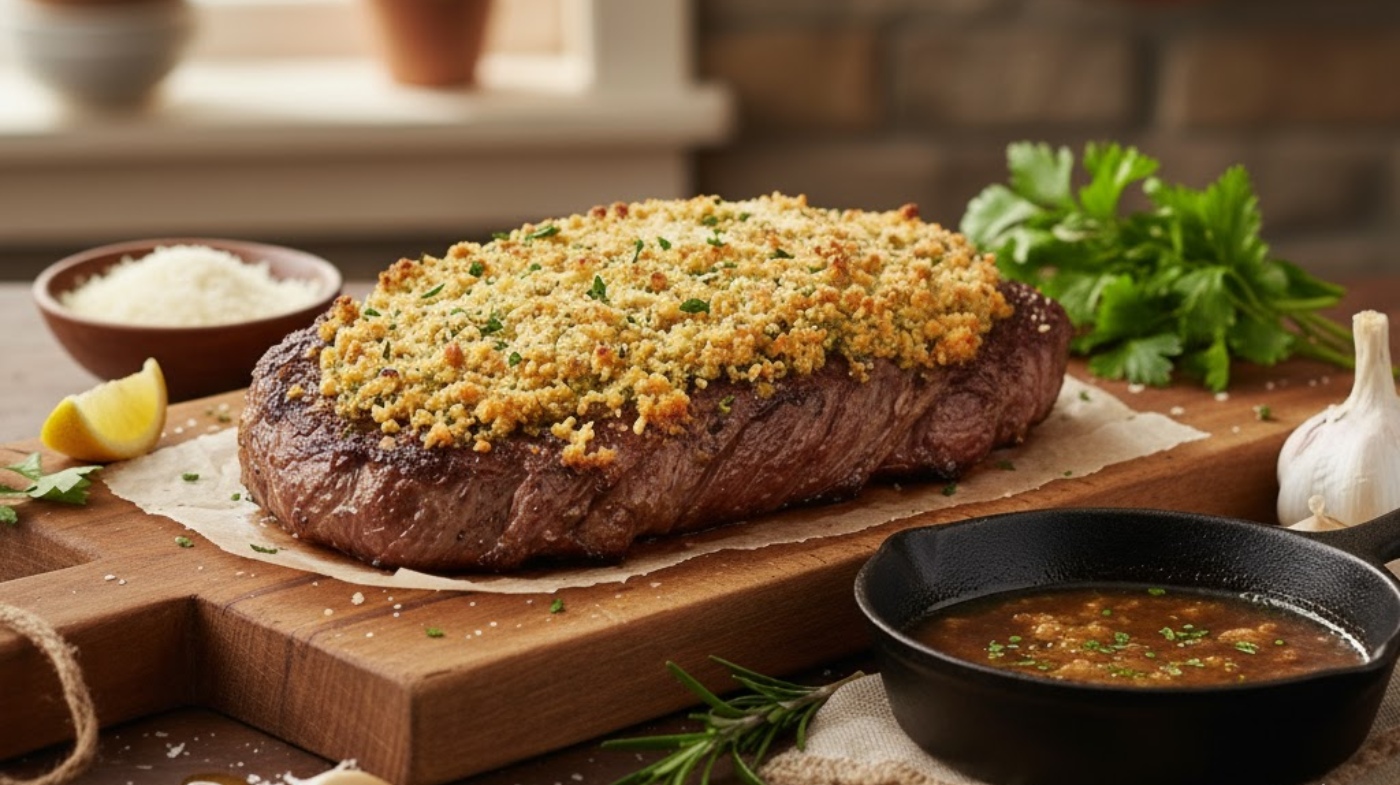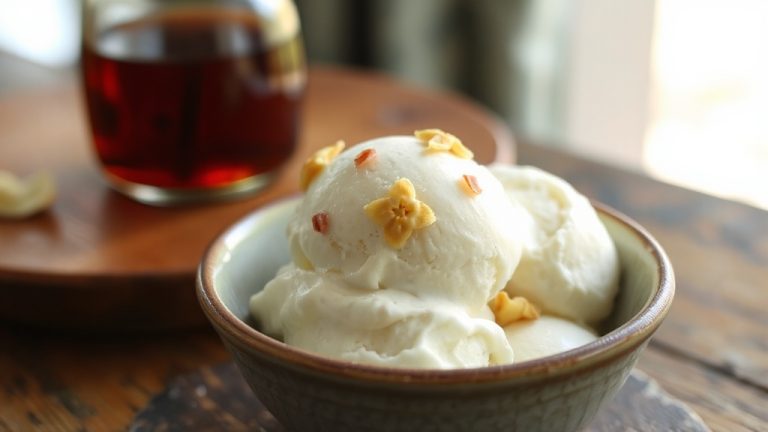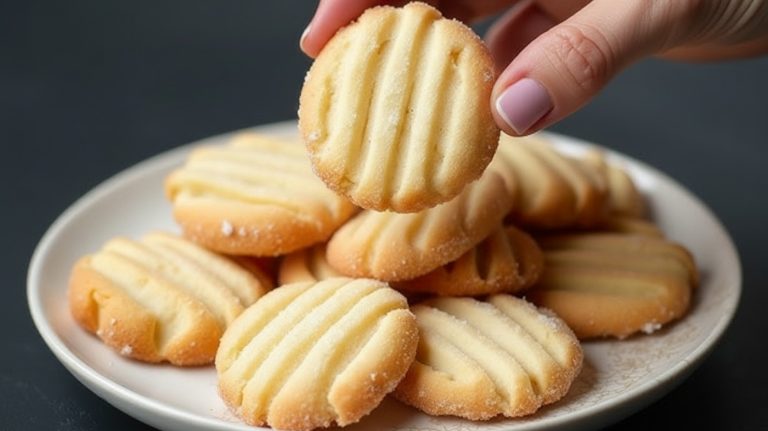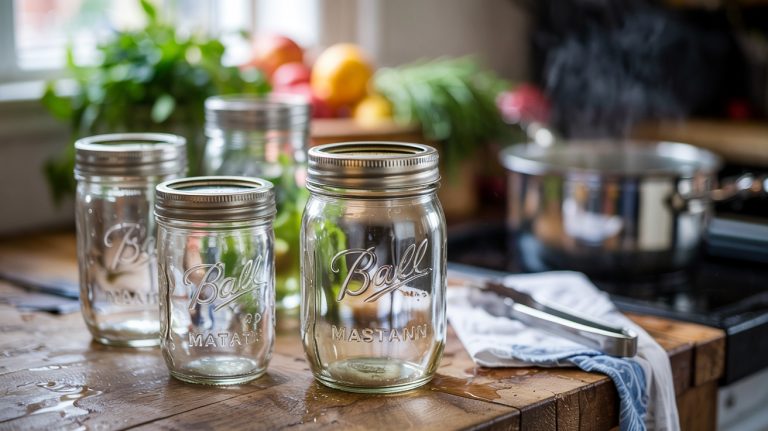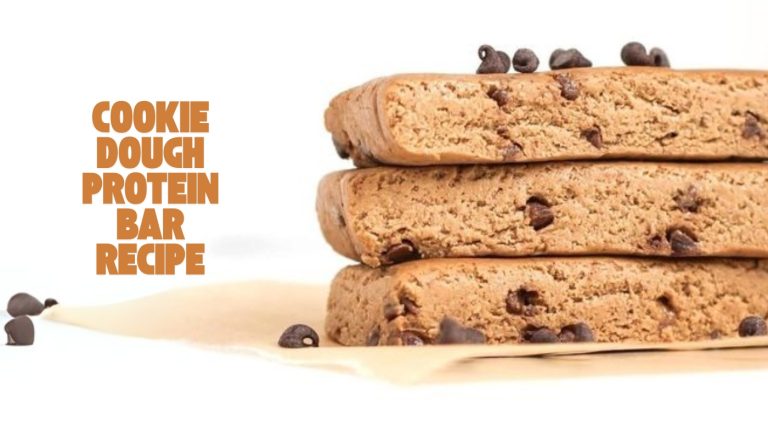How to Make a Parmesan Crust for Steak? Crispy and Delicious
To make a Parmesan crust for your steak, start by blending freshly grated Parmesan, softened butter, and panko breadcrumbs with seasonings like garlic powder and parsley.
Season your steak well, sear it for a nice crust, then spread the mixture evenly on top. Broil the steak just until the crust crisps and turns golden.
Let it rest briefly before serving to seal in juices. Keep going to explore tips on perfecting texture and flavor balance.
Key Takeaways
- Mix freshly grated Parmesan, softened butter, panko breadcrumbs, and seasonings to form a flavorful, crunchy crust mixture.
- Pat steak dry, season with salt and pepper, and lightly coat with oil or butter before applying the Parmesan crust.
- Apply the Parmesan crust evenly about 1/4–1/2 inch thick for balanced texture and browning.
- Broil the crusted steak 4–6 inches from the heat source for 1–3 minutes until golden and crispy, monitoring closely.
- Rest steak 5–10 minutes after broiling to let juices redistribute and maintain crust crispness before serving.
Quick Guide to Crafting the Perfect Parmesan Steak Crust
| Ingredients / Tools | Steps / Actions |
|---|---|
| Steak (Filet Mignon, NY Strip, Ribeye, Tomahawk) | Pat dry, season with salt, pepper, and olive oil or butter. Rest 30–60 minutes at room temperature. |
| Freshly grated Parmesan cheese (1 cup) | Grate fresh Parmesan to medium-coarse texture. Mix with butter and breadcrumbs. |
| Softened butter (½ cup) | Combine with Parmesan and breadcrumbs to form a spreadable paste. Chill for easier application. |
| Panko breadcrumbs (½ cup) | Add for extra crunch. Mix thoroughly with cheese and butter. |
| Optional herbs: parsley, thyme, rosemary | Mince and mix into crust mixture for flavor enhancement. |
| Seasonings: garlic powder, black pepper, salt | Mix evenly into crust mixture to ensure balanced flavor. |
| Food processor or whisk | Blend ingredients into a consistent, spreadable paste. |
| Oven-safe skillet or cast iron pan | Preheat for searing steak before applying crust. |
| Broiler or oven | Broil 4–6 inches from heat for 1–3 minutes until golden and crispy. Monitor closely. |
| Serving tools: knife, cutting board | Rest steak 5–10 minutes before slicing against the grain. Serve with preferred sides. |
Choosing the Right Steak for a Parmesan Crust
When choosing the right steak for a Parmesan crust, you’ll want to contemplate both the cut’s fat content and flavor profile to achieve the perfect balance.
Filet mignon, with its naturally lower fat content, pairs beautifully with the rich, savory crust, letting the Parmesan shine without overwhelming your palate. Proper knife maintenance, including regular sharpening techniques, ensures clean cuts that preserve the steak’s texture.
Filet mignon’s lean profile perfectly highlights the rich, savory Parmesan crust without overpowering the flavors.
If you prefer a bit more beef flavor, opt for a New York Strip Steak; it offers moderate fat and a robust taste that complements the crust nicely.
While ribeye steaks boast intense marbling and flavor, they can overshadow the Parmesan crust unless you choose thick cuts and season carefully.
For a special occasion, a tomahawk steak, a thick ribeye variant, works wonderfully with a Parmesan herb crust, delivering a hearty, flavorful experience that balances fat and richness effectively. Thicker cuts are best suited to prevent overcooking during the broiling step, ensuring the crust crisps perfectly without drying out the meat.
Essential Ingredients for the Parmesan Crust
To kick things off, you really want to use freshly grated Parmesan cheese. It brings such a rich flavor and gives you that perfect crust texture. Trust me, it makes a difference!
Next up, don’t forget about softened butter. This ingredient is super important because it helps bind everything together and ensures you get that lovely golden, crispy finish.
Now, let’s talk about panko breadcrumbs. They’re great for adding structure and crunch to your crust. Who doesn’t love a little extra crunch, right? The combination of these ingredients creates a crispy texture that enhances the steak’s flavor beautifully.
And if you’re feeling adventurous, consider tossing in some optional herbs and spices. They can really elevate the overall taste and make your dish sing.
Key Cheese Selection
Selecting the right cheese is essential for crafting a Parmesan crust that enhances your steak’s flavor and texture. Choose high-quality, aged Parmesan or authentic Parmigiano-Reggiano for its sharp, nutty, and slightly salty profile. This complements the steak’s richness without overpowering it.
Always grate the cheese fresh from a block to avoid clumping and ensure even melting. Opt for a medium-coarse grate to balance meltability and texture, allowing the cheese to crisp perfectly under heat.
For added complexity, consider blending Parmesan with blue cheese, adjusting ratios to your taste. Blue cheese melts quickly and requires broiling to create a crusty top, adding a distinctive flavor dimension.
Butter’s Role Explained
Although Parmesan provides the crust’s signature flavor, butter plays a crucial role in binding the cheese and breadcrumbs together, ensuring an even, cohesive layer that clings perfectly to your steak.
You’ll want softened butter mixed thoroughly with Parmesan to achieve a spreadable consistency. Chilling this mixture before applying helps it hold shape under the broiler, creating a crisp, golden crust rather than melting away. Using dimming capabilities in your kitchen lighting can enhance the visual appeal of your cooking process.
Keep these points in mind when working with butter:
- Acts as a binder for uniform crust coverage.
- Adds rich, creamy flavor balancing Parmesan’s saltiness.
- Supports browning and crisp texture during broiling.
- Controls moisture to avoid dryness or sogginess.
Additionally, preparing the parmesan crust mixture with butter, parmesan, and panko in a food processor helps to create a finely blended parmesan crust mixture that cooks evenly.
Breadcrumbs and Additions
Butter sets the foundation for the Parmesan crust, but the texture and flavor come alive with the right combination of breadcrumbs and flavorful additions.
Use 1/4 to 1/2 cup of panko breadcrumbs for a light, crispy texture that complements the rich cheese.
Mix in freshly grated Parmesan, about 1/2 to 1 cup, to enhance savory depth.
Add minced garlic or granulated garlic for aromatic punch, and fresh herbs like parsley, thyme, or rosemary to brighten the flavor. Incorporating herbs not only adds freshness but also mirrors the aromatic herbs used in dishes like Cheesy Herb Garlic Bread.
Black pepper adds subtle spice, while optional ingredients like Dijon mustard or smoked paprika can introduce tangy or smoky notes.
Combine these ingredients thoroughly with softened butter to create a cohesive crust that crisps beautifully when broiled or seared, locking in flavor and texture.
Preparing the Parmesan Crust Mixture
When you prepare the Parmesan crust mixture, start by finely grating about a cup of fresh Parmesan cheese to guarantee rich flavor and smooth melting.
Then, combine it with softened butter, about half a cup, to bind and enrich the crust. Add half a cup of panko breadcrumbs for crispness and texture. Using ingredients that bind well ensures a sturdy crust that holds on the steak during cooking, similar to how adhesive properties in lighting fixtures maintain their position securely.
To enhance flavor and adhesion, mix in a touch of mayonnaise or Dijon mustard along with seasonings like salt, garlic powder, dried parsley, and black pepper.
Use a food processor or whisk to blend ingredients into a consistent, spreadable paste.
Make certain the butter is softened to avoid a runny mixture.
Mix thoroughly for even distribution of cheese, butter, and crumbs.
Chill the mixture before applying to hold its shape and meld flavors. This preparation helps create a creamy, tangy, and flavorful Parmesan crust that complements the smoked steak perfectly.
Tips for Achieving the Perfect Crust Thickness
Getting the crust thickness just right is essential for achieving a golden, crispy layer that enhances your steak without overpowering it. Aim for about 1/4 to 1/2 inch thickness to form a distinct, even layer that browns uniformly without burning. A well-prepared crust mixture includes butter, bread crumbs, parmesan cheese, garlic, salt, and pepper to deliver the best flavor and texture.
Avoid making it too thin, which risks quick drying and uneven texture, or too thick, which insulates the steak and hinders proper cooking. Form the crust mixture with a balanced binder, chill it into a firm log about 2 inches in diameter, then slice evenly for consistent coverage. Use a durable container to chill the crust mixture evenly and maintain its shape during preparation.
Apply slices evenly, pressing gently to adhere without compacting. Keep the steak at least 1 inch thick to maintain doneness, and broil for 2-3 minutes under medium-high heat for ideal crust and interior balance.
How to Season Your Steak Before Applying the Crust?
Although the Parmesan crust will add rich flavor and texture, properly seasoning your steak beforehand is essential to build a flavorful foundation. Start by patting your steak dry to remove moisture. Using an airtight storage container for your seasonings ensures they stay fresh and potent.
Then let it rest at room temperature for 30-60 minutes to ensure even seasoning absorption. This step also allows the high marbling in ribeye steak to render slightly, enhancing tenderness and flavor during cooking.
Lightly coat the steak with olive oil or butter to help seasonings stick and enhance crust adhesion.
Use kosher or sea salt and freshly ground black pepper for balanced flavor without drawing out too much moisture.
Season evenly on all sides for uniform flavor penetration.
Gently press seasonings into the meat without bruising fibers.
Incorporate garlic powder, herbs, or smoked paprika for complexity.
Avoid oversalting to maintain tenderness and crust crispness.
This careful seasoning primes your steak perfectly before applying the Parmesan crust.
Cooking Methods Before Applying the Parmesan Crust
Before you dive into applying that delicious Parmesan crust, let’s talk about some great cooking methods you can use to amp up the flavor.
First off, consider gently smoking the steak. It’s a fantastic way to infuse a rich, smoky aroma that really takes things to the next level. Remember to always clean and maintain your chef coat properly after cooking to handle any grease or food stains that might occur during smoking.
Then, there’s oven baking. This method is great because it provides even heat, which helps set that crust just right without overcooking the meat. Using a low-temperature oven around 100°C helps the steak cook evenly and retain juiciness by drying the surface before searing slow, even cooking.
And don’t forget about pan searing! It’s super quick and creates a deep, caramelized crust. Plus, it locks in those juicy flavors and adds some lovely texture before you layer on the Parmesan. To keep your kitchen attire spotless during this process, treat any grease or oil stains promptly with dish soap for effective breakdown.
Smoking for Flavor
When you smoke steak for flavor, controlling temperature and smoke type is crucial to building a rich base before adding the Parmesan crust.
Start by preheating your smoker to 225°F–250°F, ensuring indirect heat to avoid flare-ups. Use wood chunks like cherry or pecan to infuse distinct smoky tones. Maintaining a consistent water temperature helps activate the smoke’s flavor compounds effectively.
Before smoking, dry brine your steaks with kosher salt and season with your preferred rub to enhance flavor and texture. The “slow and low” method helps achieve even cooking and deep smoke infusion.
Keep these steps in mind:
Place steaks on grates spaced for even smoke circulation.
Insert a probe thermometer to track internal temperature, aiming for 115°F–125°F.
Incorporate a water pan to maintain moisture and prevent drying.
Smoke thicker cuts slowly (1–2 hours) to maximize tenderness and smoke absorption.
This method creates a flavorful foundation for your Parmesan crust.
Oven Baking Technique
Since achieving a perfect sear is essential for developing flavor and texture, preheat your oven to 400–450°F.
Use a cast iron or oven-safe skillet to guarantee even heat distribution. Position the oven rack in the middle for baking, ensuring consistent heat exposure. Using a cast iron skillet is preferred for optimal searing and even cooking, as it retains and distributes heat exceptionally well. Keep in mind that materials like cast iron are preferred because they maintain even heat distribution better than other pans.
After searing your steak on both sides in the hot skillet, transfer the entire pan to the preheated oven to finish cooking.
Bake the steak for 4–15 minutes, depending on thickness and your preferred doneness.
Use an instant-read thermometer to monitor internal temperature, removing the steak 5–10°F below your target to account for carryover cooking. This method helps achieve the desired internal temperature.
This precise oven baking method locks in juices and readies your steak perfectly before applying the Parmesan crust.
Pan Searing Benefits
Although you can choose various cooking methods, pan searing offers unmatched control over heat and flavor development, making it ideal for preparing your steak before applying the Parmesan crust.
This technique lets you precisely regulate heat to form a perfect crust without overcooking the interior. Pan searing also locks in juices while developing a rich, caramelized surface, which is similar to how Maillard browning enhances flavor in many cooking applications.
Key benefits include:
- Precise heat control enhances crust formation and internal doneness.
- Maillard browning seals juices, preserving tenderness and flavor.
- Frequent flipping ensures even cooking and beautiful browning.
- The stovetop setup allows easy addition of butter, garlic, and herbs for basting.
Furthermore, pan searing helps minimize the risk of uneven cooking by offering better heat management compared to other methods.
Using pan searing sets a flavorful foundation that complements the Parmesan topping beautifully.
Applying and Firming Up the Parmesan Crust
Before applying the Parmesan crust, make sure your steaks are well-seasoned and dry to help the mixture adhere properly. Using a cheese melter can help achieve a uniform melt if finishing the crust in the kitchen.
Slice the chilled Parmesan crust log into portions sized for each steak.
Place the steak on a heat-safe surface and evenly spread or press the crust slice on the top surface, forming a compact, uniform layer.
Avoid covering the sides or bottom to ensure excellent browning on top.
To firm up the crust, gently press it onto the steak with a spatula, reducing the risk of detachment during cooking.
If time allows, chill the crusted steak briefly or place it on a preheated skillet at medium-high heat for a short moment to set the crust base. Using unsalted butter in the crust mixture helps it bind well and adds flavor.
Broiling Techniques to Melt and Brown the Crust
When you broil Parmesan-crusted steaks, positioning the oven rack 4 to 6 inches below the broiler element guarantees even melting and a golden-brown crust. Preheat your broiler and cast iron skillet for 5–10 minutes to ensure intense, direct heat.
Place steaks carefully to avoid splatter and monitor closely, as the crust browns rapidly. Keep the oven door slightly ajar to release steam and focus heat on the crust.
Carefully place steaks to prevent splatter and watch closely as the crust quickly turns golden.
Broil steaks for 1–3 minutes, checking every 30 seconds near the end. After broiling, allow the steaks to rest for a couple of minutes to retain their juices and enhance flavor, as resting is crucial for optimal steak texture and taste. resting period
Adjust the rack lower or switch the broiler to low after searing to prevent burning. Use finely grated Parmesan mixed with butter and panko for even browning and crisp texture.
This method creates a bubbly, golden crust without charring.
Resting and Serving Your Parmesan Crusted Steak
Once you’ve achieved a perfectly broiled Parmesan crust, let the steak rest for 5 to 10 minutes to allow the juices to redistribute evenly.
Rest the steak loosely tented with foil or on a warm plate to retain heat and preserve crust texture. Avoid over-resting to prevent cooling below ideal serving temperature.
Using an instant-read thermometer can help ensure the steak reaches the perfect internal temperature for your preferred doneness.
Before serving, slice against the grain for maximum tenderness.
| Resting Time | Internal Temp (°F) | Tips |
|---|---|---|
| 5 minutes | 130 (medium-rare) | Tent loosely with foil |
| 10 minutes | 140 (medium) | Rest on warm plate or pan |
| Avoid >10min | Avoid <120 or >150 | Use instant-read thermometer |
Serve immediately to enjoy juicy, tender steak with a crisp, golden Parmesan crust.
Pairing Suggestions and Side Dishes for Parmesan Crusted Steak
How can you elevate your Parmesan crusted steak to a complete dining experience? Pair it thoughtfully with sides and flavors that complement its rich, savory profile.
Add fresh brightness with a tomato herb chimichurri sauce. Balance the richness by serving garlic mashed potatoes or roasted green beans. Using a cast iron skillet to sear your steak before adding the Parmesan crust can enhance its crispy texture and flavor.
Consider these pairing and side dish ideas:
- Garlic mashed potatoes for comforting, bold flavor.
- Roasted asparagus or green beans for crisp contrast.
- Tomato herb chimichurri for a fresh, herbaceous kick.
- Pinot Noir or Cabernet Sauvignon to complement the steak’s richness.
These pairings will round out your meal with complementary textures and flavors.
Frequently Asked Questions
Can I Use Other Types of Cheese Instead of Parmesan?
Yes, you can use cheeses like Asiago, Pecorino Romano, or Grana Padano as substitutes for Parmesan.
They offer similar sharpness and firm textures that help form a crisp crust. Just adjust broiling time to prevent burning, since melt points vary.
Combining cheese with breadcrumbs and a binder like mayonnaise or butter improves adhesion and crunch.
Avoid soft or very greasy cheeses, as they won’t create the desired savory, crispy crust on your steak.
How Long Can I Store the Parmesan Crust Mixture?
Like a delicate flower, your Parmesan crust mixture stays fresh for about 5-7 days in the fridge when stored properly.
Keep it in an airtight container away from moisture and strong odors.
For longer life, freeze it; this can extend freshness up to 12 months.
Always label the container with the date and check for any signs of mold or rancidity before use to guarantee your crust stays flavorful and safe.
Is It Possible to Make a Gluten-Free Parmesan Crust?
Yes, you can definitely make a gluten-free Parmesan crust.
Just substitute regular flour with almond flour or another gluten-free alternative.
Combine grated Parmesan cheese, almond flour, and seasonings, then bind with beaten eggs or egg whites for better adhesion.
This mixture crisps beautifully when cooked, giving you a crunchy, golden crust without gluten.
Always check your Parmesan brand to verify it’s gluten-free, and you’ll have a delicious, safe crust for your steak.
Can I Prepare the Parmesan Crust in Advance for Meal Prep?
Absolutely, you can prepare the Parmesan crust ahead. It’s like setting the stage for a perfect performance.
Mix your finely grated Parmesan with softened butter and herbs, shape it into a log, then chill or freeze it.
When it’s time, simply slice off what you need. This method locks in flavor and freshness, streamlines meal prep, and guarantees a crisp, delicious crust every time you cook your steak.
What Is the Best Way to Reheat Parmesan Crusted Steak?
The best way to reheat parmesan crusted steak is to use a low oven temperature around 250°F (121°C) for 20–30 minutes, letting it warm evenly without drying out.
Then, quickly sear it in a hot skillet for 1–2 minutes per side to crisp the crust back up. This method preserves juiciness and restores texture, giving you a perfectly reheated steak that tastes almost freshly cooked.
Achieve the Perfect Crunch: Master Your Parmesan Crust Today
Now that your steak boasts a golden, crispy Parmesan crust, imagine slicing into its juicy, tender center. The savory aroma fills your kitchen.
That perfect crunch gives way to rich, melted cheese with each bite, creating an irresistible texture contrast.
Rest your steak briefly before serving to lock in those flavorful juices. Pair it with vibrant sides, and enjoy a restaurant-quality meal that’s as stunning to look at as it is satisfying to savor.

